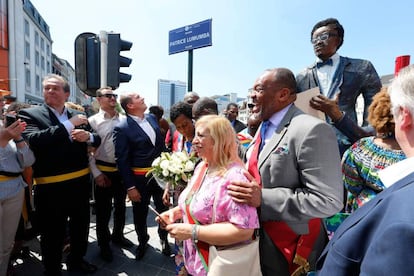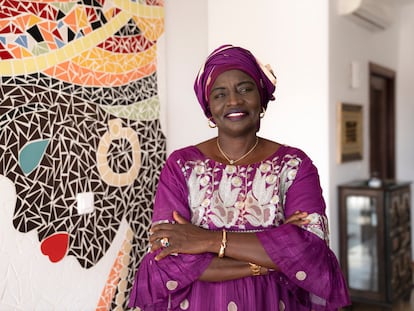Brussels’ European neighborhood seeks ways to coexist with its colonial past
Etterbeek, home to the main institutions of the EU, is working to contextualize its multiple monuments and symbols of Belgium’s legacy in the Congo
Long before Etterbeek was known for housing the main institutions of the European Union — or for being where Georges Remi, better known as Hergé, the creator of Tintin, grew up — this municipality of Brussels was famous for the numerous military barracks installed there after Belgium gained independence in the 19th century. It is a past that inevitably means it holds the largest number of references, among street names and monuments, to the sinister colonial legacy that the country has been trying to come to terms with for years, especially after the worldwide protests of the Black Lives Matter movement in 2020, which provoked a questioning of cultural symbols representing an often very racist past.
Etterbeek now wants to face that past, without erasing it. After 18 months of work by a commission formed by political representatives and residents to discuss what to do with its colonial vestiges, the mayor of Etterbeek, Vincent De Wolf, has announced a “work of contextualization” of the names of streets, statues and other monuments linked to Belgium’s colonial past. The next step will be the formation of a panel of independent experts, which will make a list of the symbols to be explained in order of priority, and the context of each of them. These explanations will foreseeably be presented on a plaque, or with a QR code next to the original monument or street name.
The idea, explains André du Bus, a local councilor and rapporteur of the commission that prepared the Etterbeek report, is that the surrounding explanation contains “all the elements identified as problematic and raising questions” about the character or element in question, but also to avoid “meaningless excesses.” “It’s about citizens taking ownership of the issues and opening a debate,” says Du Bus, whose report also proposes holding an annual “cultural, social and sociological event to educate about colonial and decolonization challenges.” The information to be proposed, he stresses, “will have to be precise, factual, which is why it has been entrusted to a panel of experts.” Mayor De Wolf has indicated his intention to move quickly, so that everything will be in place before the municipal elections to be held just a year from now.
But it won’t be an easy job, Du Bus warns. Etterbeek is host to the largest concentration of the “fingerprints of Belgium’s colonial past: 26 of the 185 streets refer to military men related to that past,” he notes. In addition, various monuments dot the streets. Some extol participants — from prominent military men to anonymous pioneers — in the brutal management and repression of the Congo during Belgian rule, particularly the period from 1885 to 1908, when the now independent Democratic Republic of the Congo was the personal property of King Leopold II of Belgium, under whose brutal rule an estimated 10 million people died, but also during the Congo’s tenure as a Belgian colony, from 1908 until its independence in 1960. Others, such as the statue L’Archer, of a Black warrior with his bow, are dedicated to the native Congolese, but in a manner that many consider anonymous and stereotypical.
Despite the challenges involved, experts of various stripes agree that contextualizing is a welcome step in the framework of a critical reflection on Belgium’s colonial past that the country initiated a few years ago, first with the profound change of perspective of the once pro-colonialist Royal Museum for Central Africa, and now with initiatives like the one in Etterbeek, which are also being progressively worked on throughout the Brussels region.
“Contextualization is the foundation, the minimum,” says law professor Marie-Sophie de Clippele, who participated in the preparation of a report titled Working on decolonizing public spaces in the Brussels-Capital Region, published last year and which forms the basis for analyzing different steps to be taken in a city riddled with colonial monuments and symbols, even in its renowned art nouveau buildings. The report stresses that the decolonization of public space is “an integral part of the decolonization of society, which requires an ongoing social, political and cultural process that should not be limited to Belgium’s colonial past, but should be inscribed in other fields such as health, housing, education or employment” to build a region “in which every Brussels citizen recognizes themselves and feels recognized.”
Philologist Philipp Buyck — a decolonization activist who is largely responsible for the fact that Brussels today has a square dedicated to Patrice Lumumba, the hero of the Congo independence movement who was assassinated in 1961 — would like the whole process to go even further and also extend to the European role in the post-colonial era. But he agrees that the commitment to contextualization is a step in the right direction because the alternative, removing the symbols, as some have demanded, would be “mutilating history.” Besides, he adds with a wink, to remove them is to “end the possibility of talking” about the subject, because they are “the ideal decor” to “denounce issues around colonization.”
“A statue is often erected in memory of a certain version of history, which does not tell the whole story,” De Clippele notes. “I believe that statues should not be removed; it is better to contextualize them, in an inclusive way if possible, and to make people understand that these statues, on their own, do not tell the story, but they are the version of the period that they wanted to show.” For his part, Du Bus says that he would not be opposed to some street names being removed “if it is shown that they are really problematic characters.” But not as a principle. “I am not a revisionist. I am opposed to the removal, from one day to the next, of a whole plane of colonial history, because it doesn’t make sense; it’s part of our history.”

The death George Floyd at the hands of a white police officer in Minneapolis in May 2020 sparked a wave of demonstrations that quickly spilled across U.S. borders. In many European countries with a colonial past, such as the United Kingdom, France or Belgium, protests against still persistent racism broke out and monuments of that colonialist legacy were attacked. In Belgium, many statues, especially those dedicated to Leopold II, were stained with red paint.
Although the initial anger seems to have subsided, the wound is still open three years later. Proof of this lies in Etterbeek itself, where a monument “in honor of the Belgian pioneers in the Congo” in the Cinquantenaire park, close to the European Commission headquarters, still shows traces of red paint that an activist threw against the work in mid-September to denounce “the blood that Belgium has on its hands.”
Will the contextualization of colonial symbols put an end to attacks on monuments? Du Bus is unsure. “Contextualization seeks above all to sensitize the population. It’s about pacifying, giving ample information to everyone. Will it be enough? I don’t know,” he confesses. What he is convinced of is that this task of contextualization must be a collective work, with professional advice to ensure the participation of all those involved: “Changing the name of a street or square cannot be a unilateral decision. It needs the support of the citizens’ will.”
Sign up for our weekly newsletter to get more English-language news coverage from EL PAÍS USA Edition
Tu suscripción se está usando en otro dispositivo
¿Quieres añadir otro usuario a tu suscripción?
Si continúas leyendo en este dispositivo, no se podrá leer en el otro.
FlechaTu suscripción se está usando en otro dispositivo y solo puedes acceder a EL PAÍS desde un dispositivo a la vez.
Si quieres compartir tu cuenta, cambia tu suscripción a la modalidad Premium, así podrás añadir otro usuario. Cada uno accederá con su propia cuenta de email, lo que os permitirá personalizar vuestra experiencia en EL PAÍS.
¿Tienes una suscripción de empresa? Accede aquí para contratar más cuentas.
En el caso de no saber quién está usando tu cuenta, te recomendamos cambiar tu contraseña aquí.
Si decides continuar compartiendo tu cuenta, este mensaje se mostrará en tu dispositivo y en el de la otra persona que está usando tu cuenta de forma indefinida, afectando a tu experiencia de lectura. Puedes consultar aquí los términos y condiciones de la suscripción digital.
More information
Archived In
Últimas noticias
Welcome to the post-religion era: The idea of Christianity as the absolute truth has become obsolete
‘I thought you would like it’: The risky sexual practice popularized by TV shows and TikTok
The digitalization of tourism: ‘They promise experiences and gave us the worst possible one’
Mexican peso defies uncertainty with forecasts of a new period of stability in 2026
Most viewed
- Sinaloa Cartel war is taking its toll on Los Chapitos
- Reinhard Genzel, Nobel laureate in physics: ‘One-minute videos will never give you the truth’
- Oona Chaplin: ‘I told James Cameron that I was living in a treehouse and starting a permaculture project with a friend’
- Why the price of coffee has skyrocketed: from Brazilian plantations to specialty coffee houses
- Silver prices are going crazy: This is what’s fueling the rally











































